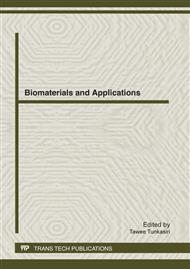p.234
p.238
p.242
p.246
p.250
p.254
p.258
p.262
p.266
A New Approach for the Preparation of Bleached Shellac for Pharmaceutical Application: Solid Method
Abstract:
With increased awareness about the environment, raw materials from petroleum based synthetics and the "green" quotient of consumer products have developed, shellac or shellac modified resins have gained importance due to their unique nontoxic and hypoallergenic properties. Shellac is water soluble, biologically degradable and has film forming, excellent adhesion, hardness, high gloss and superior in electrical properties. Shellac or shellac modified resins are also compatible with other resins and can be cross linked making them a wider applications. Shellac is abundant in Thailand, China and India, which produced from lac insects, Laccifer Lacca. The resinous secretion can be purified to become shellac. The main structure of shellac consists of polyesters and single esters that have hydroxyl and carboxyl groups [1, . Shellac was first used as a wood polish for music instruments and furniture and later for uses in spar varnishes with antifouling properties for ship paints, phonographic records, wood and wallpaper paints, printing inks, resins for electrical applications and floor polishes. Currently, new applications for using are such as child-safe paints and inks and the coating of fruits and vegetables, food and confectionary, pills, tablets and vitamins in the pharmaceutical industries. Bleached shellac has been widely used in pharmaceutical and cosmetics instead of native shellac due to the whiteness. However, conventional method for bleached shellac used many solvents [3, . Therefore, the aim of this study was to explore a new technique in order to avoid the use of organic solvent prior to the process of bleaching. The comparison was made between bleaching by the conventional and the new methods. The studied properties were acid value, viscosity, color change, water vapor permeability, chemical structure and powder x-ray diffraction.
Info:
Periodical:
Pages:
250-253
Citation:
Online since:
April 2012
Authors:
Price:
Сopyright:
© 2012 Trans Tech Publications Ltd. All Rights Reserved
Share:
Citation:


